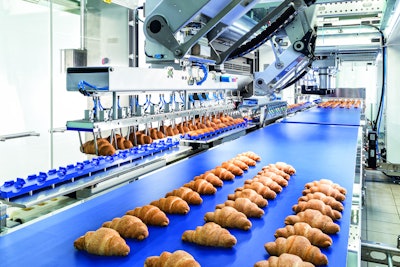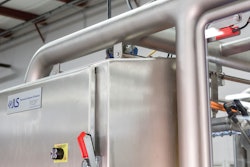Based in San Giorgio Dolce Castel near Salerno, Italy, San Giorgio & Salato produces a range of baked goods for the foodservice industry. Begun by Sabato Bruno as a tiny pastry kitchen in the 1980s, the family-owned company now employs 150 people at its state-of-the-art facility.
An innovator in the bakery market, San Giorgio Dolce & Salato was the first to introduce prebaked, filled, and frozen croissants to the restaurant trade. The idea was to combine great taste with the fast pace of modern life. The prebaked dough pieces are handy for baristas, who can quickly bake the frozen croissants and serve them to customers, saving considerable preparation time.
To succeed with this product innovation, San Giorgio Dolce & Salato required a new, fully automated system that could efficiently inject fillings into the croissants and package them while handling the baked goods extremely gently. At the ipack ima 2015 trade fair, while looking at possible technologies, the baked goods manufacturer became aware of Gerhard Schubert GmbH’s automated packaging systems.
According to Schubert, during the bidding phase, San Giorgio Dolce & Salato was impressed with the packaging supplier’s project support. From the beginning, Schubert focused on the product’s special features. One challenge was to integrate into the system’s design an injection station for the fillings from bakery machine manufacturer Canol Srl. With this in mind, Schubert Sales and Project Manager Antonino Lanza worked closely with Canol. The result is an injector precisely matched to Schubert’s robot-based technology that injects different fillings into the croissants or other baked goods while handling them gently with custom-designed robotic end effectors.
The TLM packaging system Schubert developed for the customer consists of four sub-machines, or modules, outfitted with three TLM-F4 four-axis pick-and-place robots with vision, two TLM-F2 two-axis robots, and Schubert’s proprietary Transmodul single-axis, rail-based transport robots. The TLM packaging line is fed by a conveyor that carries baked croissants from the oven to the first Schubert module for pre-grouping. Here, a 2D image recognition system checks the position of the products on the conveyor and transmits the data to the F4 robots at the next station. Controlled by two servomotors, the pick-and-place robots can execute any movements within a 2D working field. Since the croissants are delicate and vary in height, density, and consistency, the robots must handle them carefully. This is ensured by four grippers and flexible damping on the robot tools, which do not dent or damage the soft and still-warm products.
The task of the picker arms is to grasp the croissants one at a time with control done by air pressure, orient them, and place them onto a Transmodul that features 12 evenly-spaced “pucks,” or holders. The transport robot then brings the croissants to the injection station. During filling, a TLM-F2 robot with 12 vacuum gripper heads positions the croissants, while the Canol component with 12 injection needles punctures the croissants, filling them with jam, chocolate, or vanilla cream. The needles are adjustable in height, depending on how deep they need to inject the filling into the baked goods, which gives San Giorgio Dolce & Salato the flexibility to run different products on the line. Thanks to plug-in connections, the injection system can be completely removed from the main system to enable cleaning and conversion to other fillings.
Once they have been filled, the croissants, still on the Transmodul, are carried out of the injection station, after which an F2 robot picks up the row of 12 and places it back onto the conveyor belt. Meanwhile, the now empty Transmodul flips over and rotates back to the beginning of the system, ready to be loaded with more product.
Now on the conveyor, the baked and filled goods are carried through a froster and then to deep-freezing. In the final stage, the croissants are packed in flow-wrap bags either individually or in packs of three, or in cartons, at the next Schubert system.
Using this automation solution, San Giorgio Dolce & Salato can fill and package 160 croissants/min. This efficient combination of injection and final packaging process is of great benefit to the Italian company, as is the flexibility that enables different baked goods to be filled and packaged in the same system and/or in the same manner. San Giorgio Dolce & Salato is therefore able to expand its range of prebaked pastries as needed.
Watch a video of the system in operation.
See all case studies in Part I of the Robotics Special Report.





























